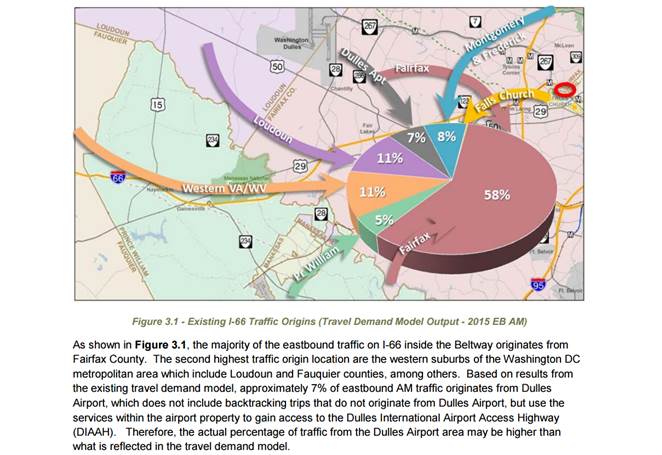UPDATE (1/25/2016):
The public hearings scheduled for Jan. 25 and 26 have been canceled due to the snow. They will be held on the following dates:
Wednesday, Jan. 27:
(Snow date on Feb.3, if necessary)
VDOT Northern Virginia District Office
4975 Alliance Drive, Fairfax, VA 22030
6:00 – 8:00 p.m.; Presentation at 6:30 p.m.
Live stream of hearing on Transform66.org starting at 6:30 p.m.
Thursday, Jan. 28, 2016 (make-up date from Jan. 25)
Washington-Lee High School Cafeteria
1301 N. Stafford Street, Arlington, VA 22201
7:30 – 9:30 p.m.; Presentation at 8 p.m.
Friday, Feb. 5, 2016 (make-up date from Jan. 26, 2016)
Stone Bridge High School Cafeteria
43100 Hay Road, Ashburn, VA 20147
6 – 8 p.m.; Presentation at 6:30 p.m.
PREVIOUS:
WASHINGTON — More traffic could be in the forecast on Interstate 66 between the Capital Beltway and Va. Rt. 7 once changes for high-occupancy lane usage take effect, according to new projections.
A draft transit projections report was made available Friday ahead of public meetings scheduled later this month.
According to the projections, next year’s changes to HOV lane usage on I-66 inside the Beltway — extending rush hour periods from 2.5 to four hours in each travel direction and charging tolls for solo drivers who want to use the lanes — would lead to an increase in traffic between the Beltway and Va. Rt. 7 in the morning, and a decrease in traffic in the afternoon.
The changes would also have an impact on drivers immediately at other intersections, from Tysons Corner to Arlington in Virginia.
The draft report reflects traffic projections that were updated after Virginia transit leaders decided against imposing new HOV restrictions or tolls on reverse commuters. That decision was made after public feedback, though data suggests overall eastbound travel times tended to be worse in the afternoon than during HOV restrictions in the morning — largely due to congestion where Dulles Access Road merges with I-66.
The projections estimate there will be no change for consistently congested stretches between Spout Run and Glebe Road, or Sycamore Street and Fairfax Drive. The projections were based on a measure known as level of service.
For 2017, when the new HOV rules take effect, the projections estimate that eastbound will get a better grade in three stretches in the morning, but worse in two stretches of 18 analyzed. The others are estimated to remain at the same level of service.
Off the highway, six intersections near I-66 will see improved operations in the morning, while three will get worse. The projections estimate that 50 other intersections will maintain similar traffic patterns.
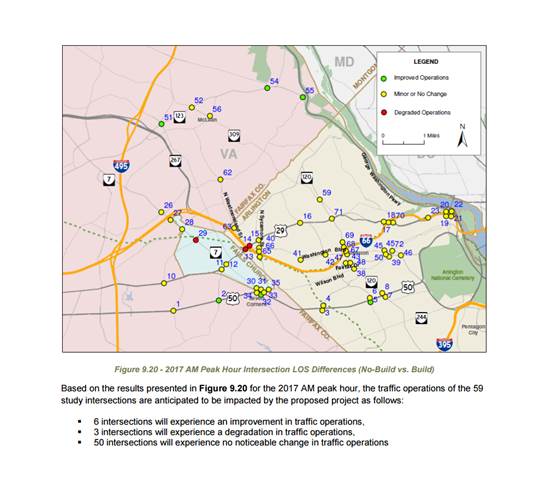 Those projections include changes at 17 intersections that would see at least 200 fewer vehicles per hour, an intersection that would have more than 200 additional vehicles per hour, and 41 intersections that are projected to see a change of fewer than 200 vehicles per hour.
Those projections include changes at 17 intersections that would see at least 200 fewer vehicles per hour, an intersection that would have more than 200 additional vehicles per hour, and 41 intersections that are projected to see a change of fewer than 200 vehicles per hour.
In the evening commute, the models project no significant negative traffic changes at any of the analyzed intersections, while four intersections are projected to improve.
The projections estimate 31 intersections would see at least 200 fewer vehicles per hour in the afternoon, 7 would see an increase of 200 vehicles per hour, and 21 that are projected to see a change of fewer than 200 vehicles per hour.
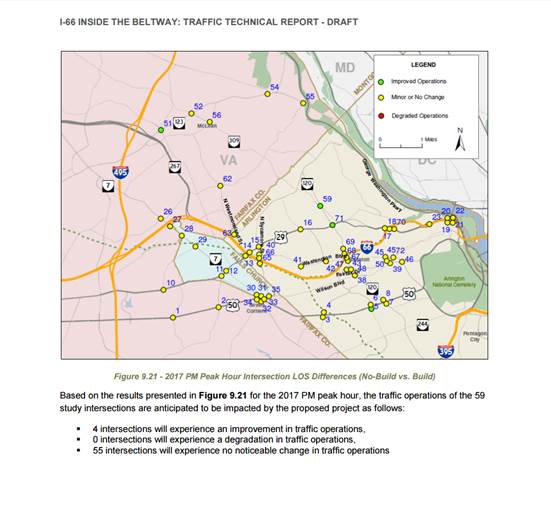
The intersections that face longer-term concerns under the plan are along Route 29 in Rosslyn and Falls Church; Fairfax Drive; Wilson Boulevard; and the interchange of Route 50 and George Mason Drive.
The Virginia Department of Transportation draft report concludes that “traffic volumes for the traditional commute (eastbound AM/westbound PM) will not be significantly impacted by the proposed project in 2017.”
“Diverted traffic to parallel arterials will not significantly impact traffic operations. In 2017, minor changes in traffic operations are expected at the arterial intersections as a result of the project,” the report states.
More significant impacts are expected by separate changes, including widening of I-66 and the transition in HOV rules that will eventually require three or more people in the car to qualify. The HOV transition is expected by around 2021. The widening is factored into the report’s projections for traffic patterns in 2040, which show increases in travel on I-66.
Motorcycles would continue to ride free.
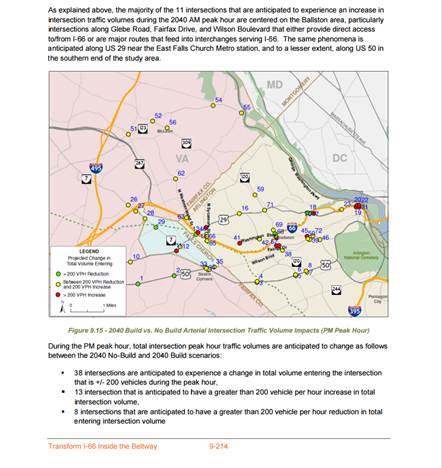
Virginia Department of Transportation hopes the expanded HOV hours and toll system will help maintain more constant speeds on the highway, which would reduce the risk of rear-end crashes.
Signs will need to explain that the HOV and toll rules only apply between 5:30 and 9:30 a.m. in the eastbound direction, and between 3 and 7 p.m. in the westbound direction. Signage would also be needed to let solo drivers how much trips will cost.
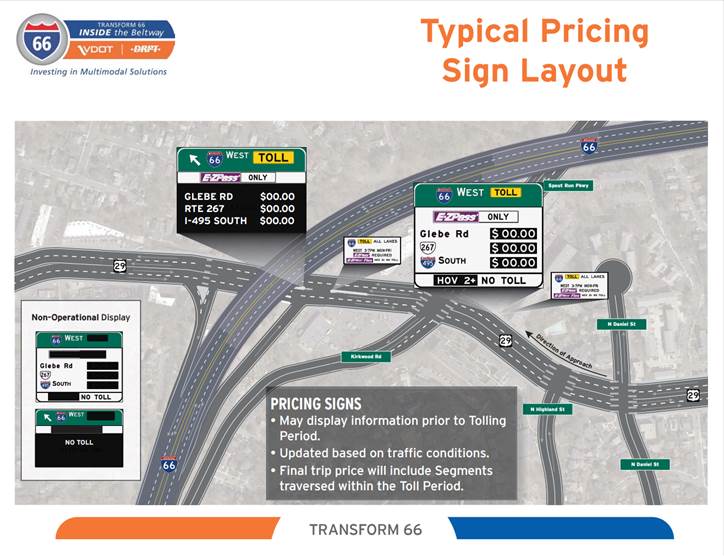
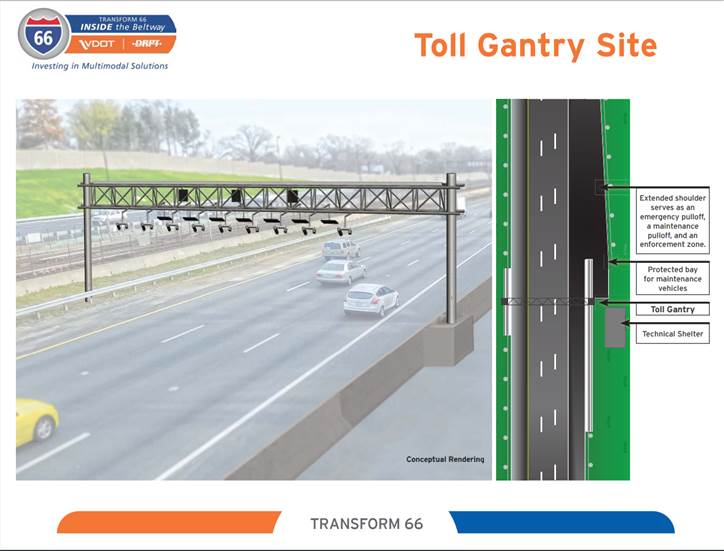
Once on the road, the actual toll gantries will look similar to those on the Intercounty Connector in Maryland or the I-95/495 Express Lanes in Virginia.
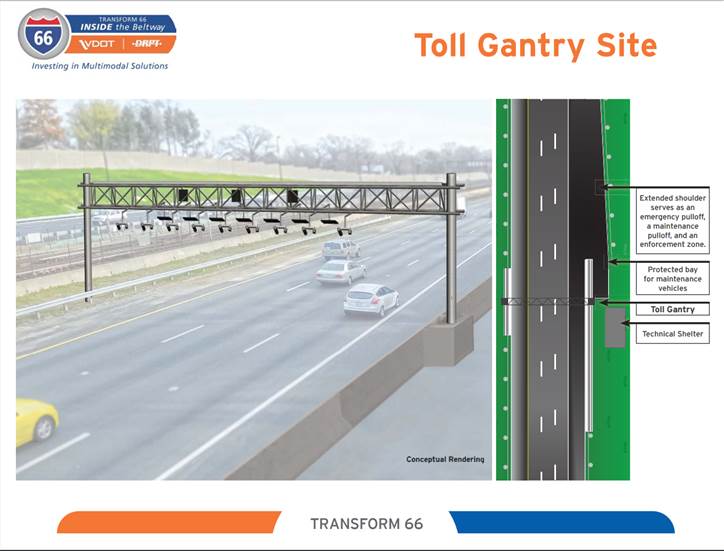
Each gantry will have an extended shoulder space, a perch for state troopers.
VDOT plans to keep all of the construction in a space that would not require any property to be taken from nearby homeowners, parks or trails. A separate environmental document states new signs would not impact the undersides of any bridges, so there “would be no effect to the Northern longeared bat.”
Tolls will be charged in four segments. There is no toll planned between the D.C. line, Rosslyn, and the Spout Run Parkway in either direction.

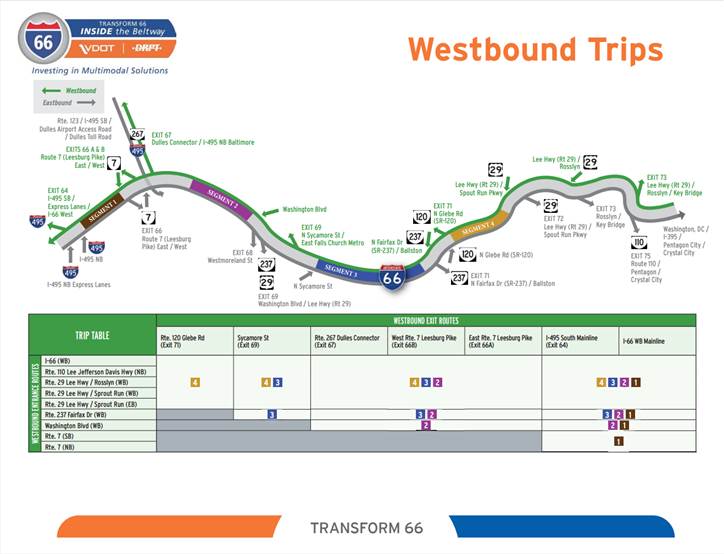
The Virginia Department of Transportation says more than a third — and as many as half of the vehicles on I-66 during the current 2.5 hour rush hour periods — are likely violating the HOV rules today.
One stated goal of the 66 project is to reduce congestion on I-66 by “better managing traffic demand and increased enforcement.”
The all-electronic toll system, which will eliminate exemptions to HOV rules for hybrid drivers or those heading to or from Dulles Airport, will allow for automated enforcement in all cases except drivers who wrongly switch their EZPass Flex into HOV mode to attempt to get a free ride.
The Virginia Department of Transportation estimates that the majority of eastbound traffic on I-66 inside the Beltway originates in Fairfax County, with a most drivers headed to Arlington and D.C.
